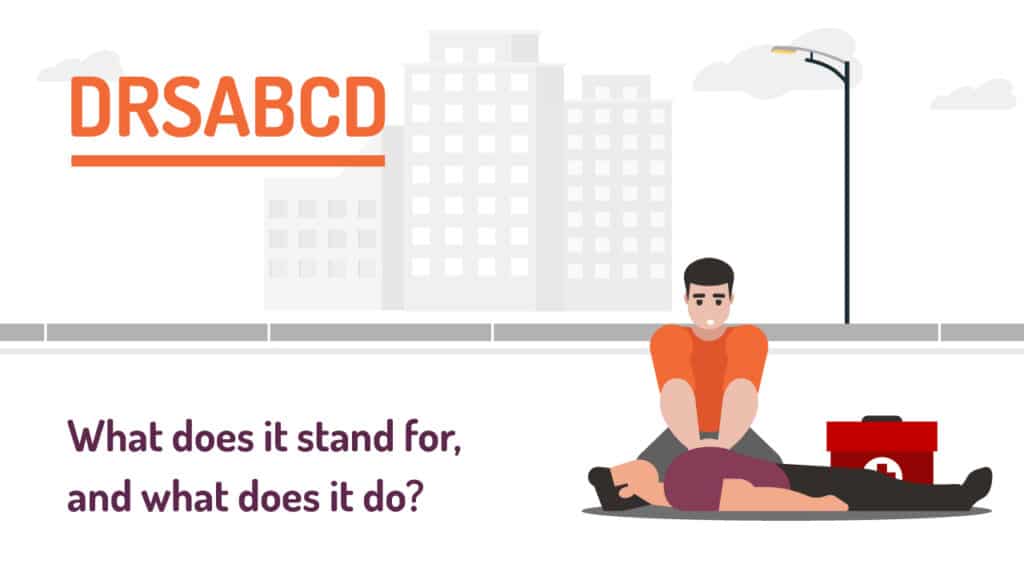What does DRSABCD stand for, and what does it do?

DRSABCD – better known as “Doctors ABCD” – is a common acronym used in first aid training. Although it looks like a bit of a mouthful, DRSABCD is actually an incredibly useful life-saving tool – a procedure that walks you through what to do when you come across someone who might be suffering a Cardiac Arrest. The letters of DRSABCD stand for Danger, Response, Send for help, Airway, Breathing, CPR and Defibrillation. Each of these is a single step in the first aid process, starting with checking for danger and ending with performing life-saving cardiopulmonary resuscitation (CPR) – and using an automated external defibrillator (AED) if there’s one nearby. Just knowing the steps doesn’t mean you’re ready to jump straight into a first aid emergency of course. Normally Drs ABCD is taught as part of formal first aid training – it’s an essential part of most first aid courses. So the seven DRSABCD steps are just a way to remember what you’ve learned about what to do in an emergency, and when to do it. Key Takeaways DRSABCD describes the steps to check an unconscious person and start CPR if needed. It’s normally said as “Doctors ABCD”. The letters stand for Danger, Response, Send for help, Airway, Breathing, CPR, Defibrillation. Each phrase is a step to complete. DRSABCD is most effective when done by someone with first aid & CPR training. CPR keeps a cardiac arrest victim alive until medical help can revive them. It won’t restart a person’s heart on its own. Defibrillation is normally needed to revive the person. A Defibrillator can revive a person in Cardiac Arrest by momentarily stopping their heart, and allowing it to restart with a more normal rhythm. DRSABCD and CPR have saved hundreds of thousands of lives. There are very few negative consequences to doing it, and the benefits far outweigh any risks. Book Your First Aid Training Today! HLTAID011 – Provide First Aid | Just $97 HLTAID009 – Provide Cardiopulmonary Resuscitation | Just $50 Certificate within 24-hours Highly Qualified Trainers Nationally Recognised Qualifications Pick A Course From The Selector Below! So what does DRSABCD stand for? The seven words or phrases of the DRSABCD process each describe a detailed step in the process of assessing and treating a possible casualty. To provide a brief overview of each term: Danger – Check the area for danger (to yourself or others) Response – Check the person to see if they conscious and able to respond Send for help – Seek medical assistance at once, normally by calling 000 Airway – Check the person’s airway is clear Breathing – Confirm if the person is still breathing CPR – Commence cardiopulmonary resuscitation (CPR) Defibrillation – Use an AED if one is available Many of these steps include decisions about what to do next, based on what you learn at that step. For example, you don’t need to commence CPR if someone is still breathing normally, and you shouldn’t approach the person to check for a response if the area is still dangerous. How is it used? DRSABCD starts when someone with first aid training enters an area and realises there is a potential casualty – normally someone lying on the ground in an unusual way. It also may start if someone collapses suddenly near the first aider with no clear explanation why. The steps walk the first aider through the process of finding out what may have happened to the person – starting by checking the area for danger, and then by assessing the person’s condition. It also describes when you should assume the person is suffering cardiac arrest and begin CPR. A first aider may not perform all the steps of the process – the best-case scenario is that the person is still conscious and in no serious danger. In a way, DRSABCD is the worst-case scenario, explaining what to do with someone who’s unconscious and not breathing – at which point they’re in imminent danger of death. What does each of the DRSABCD steps mean? Let’s have a look at each step of the DRSABCD procedure, and what’s involved at each step. Danger The first step generally describes the initial moments when a first aider realises something is wrong – when they come across a person lying on the ground, or see them suddenly collapse for no obvious reason. It reminds first responders that the first thing to do is check for ongoing danger. Although our instinct may be to rush to the aid of someone who’s sick or hurt, it’s important to be cautious. You need to check if there’s an obvious cause for the person’s condition or anything that might cause other injury. Rushing in to help when there’s a venomous snake, exposed electrical wires, or fast-moving traffic nearby could mean you just end up as a casualty yourself. If you identify danger in the area, you need to remove or control the danger. In some cases, this might involve making changes in the environment – such as switching off electricity or parking your car on the road with hazard lights on. In other cases, it may require moving the casualty. While this isn’t recommended, sometimes it’s unavoidable – performing first aid on someone lying in the middle of a busy expressway is a far bigger risk than moving them. In some cases, the danger might mean you can’t safely approach. Trying to kill or chase away an angry snake to get to the person they’ve bitten is likely to make the situation far worse. In such cases, you need to keep your distance and call for help. Once you’ve checked the area and found it to be safe, you can approach the person. Response Once you’re able to reach the person, the first thing to check is whether they can respond to someone’s voice or touch – whether they’re awake and alert. Start with simple questions or requests, speaking in a clear voice. Another common acronym used specifically for


